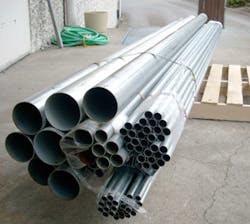Real Ways to Reduce Material Handling Costs
The main goal of any contractor is achieving a high-quality installation on time and on budget. According to in-house research, MCA, Inc., a consulting firm based in Flint, Mich., reveals that material handling tasks consume approximately 40% of field technicians' effort in the electrical construction industry. Material handling is also recognized to be the single most common cause of unproductive time on the job site (see Previous Research). Any effort to significantly improve job-site productivity can begin by addressing ways to reduce the recoverable lost time spent unnecessarily handling materials and equipment.
Figure 1 (click here to see Fig. 1) illustrates the potential benefits to electrical contractors from reductions in time spent handling materials. These benefits are achieved in the form of increased productivity through reduced time spent on unnecessary movement and handling of material, tools, and equipment.
Why would the best workers spend so much time moving and handling material? Because the correct material (in the correct quantity) is not where they need it, when they need it. Sure, it may be easy to blame the labor for being unproductive; however, the labor is simply doing the job to the best of their ability with what they have been given. The solution to material handling problems lies with management — procurement management and logistics management.
Although it's possible to acquire and vertically integrate the talent to manage procurement and material logistics within the contractor's business, it is a costly undertaking. For the vast majority of contractors, a more practical solution involves maintaining responsibility for managing procurement while soliciting the involvement of experienced vendors or distributors for logistics management. This approach comes with a few recommendations: You must select a vendor that is a suitable partner, understand the difference between purchasing and procuring job-site materials, and be prepared to spend some time learning about the businesses and business models of the chosen partner(s).
Choosing a vendor based only on material price is not going to reduce material handling costs. If the goal is to reduce job-site material handling, then the cost of the material is far less important than the effective use of labor. Contractors need to ask their suppliers what they can do to provide the correct material at the installation location at the time the labor is ready to install it. The contractor should expect to pay a little more for the material if that cost includes such services as:
-
Specification verification
-
Submittal preparation support
-
Receiving, inspection, and damage claims support
-
Offsite storage at the vendor's secure warehouse
-
Preassembly of selected components
-
Wire cutting and paralleling
-
Testing of equipment when necessary
-
Kitting and packaging in job packs suitable for installation
-
Staged deliveries to the job site, as the material is needed (Photo 1)
-
Stocking and restocking onsite commodity boxes and trailers (Photo 2)
-
Material returns processing
-
Job-site material clean-off
Over the past several years, an increasing number of electrical contractors have been successfully working with their supplier partners to achieve the goal of reduced lost time from handling material. The overall results of these efforts have been to improve productivity and profitability by striving to deliver complete projects at the lowest installed cost. The distributor's advantage in these partnerships is also higher profits and more secure sales.
One important factor to remember here is lowest installed cost does not mean cheap. In fact, lowest installed cost is the only way to deliver projects with the highest possible value to the customer. Furthermore, lowest installed cost does not mean lowest priced material. In the end, paying more for the material can improve the contractor's profit margin.
The basic premise of lowest installed cost is that the contractors can manage the tradeoff between material cost and labor savings to provide greater value to the customer, greater sales to the supplier, and greater profits to themselves. Another way of viewing this is the return on investment in vendor services. With an efficient partnership, based on mutual understanding of each others' business needs and operations, finding a win-win solution is not only doable, but almost unavoidable. The calculation in Fig. 2 shows the return on a modest 2% investment in material price, resulting in a willing vendor partner helping the contractor to reduce material handling labor costs by 25%.
Although the activities and results shown here are real and unembellished, the effort and the time required to develop these types of relationships cannot be shown. For more than a decade, progressive contractors have been pursuing innovative ways to improve their vendor relationships. For these companies, the traditionally adversarial nature of the supply chain can be, and has been, changed to one of cooperation and increased profitability for all stakeholders. Many of these companies come together to collaborate their applications and their results regularly, and always invite others to participate.
Moore is an associate implementer and Nimmo is director of operations with MCA, Inc., Flint, Mich. They can be reached at [email protected] and [email protected].
Sidebar: Previous Research
Research results from MCA, Inc., indicate the top 10 causes for lost productivity on job sites include:
-
Waiting for material (warehouse or offsite)
-
Waiting for tools and equipment
-
Waiting for equipment breakdowns to be fixed
-
Rework due to design, prefabrication, or field errors
-
Interface from other crews
-
Overcrowded work areas
-
Workplace changes
-
Waiting on permits
-
Waiting for instructions
-
Other delays — the most common of which is waiting for scaffolding to be put up or taken down
